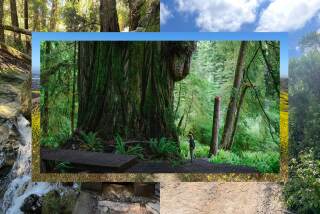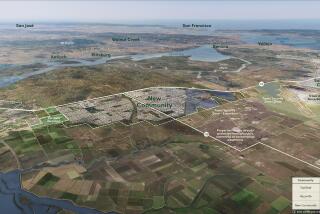Director Sure Parks Can Turn Green
Johnny Johnston is in a bind. Faced with an excruciatingly tight budget of $1.2 million, the county’s General Services Agency director is under orders to do what few have done before: turn public parks into moneymakers.
Johnston has virtually no road map for his task. Many of his ideas have been met by public derision. One resident, incensed by a proposal to turn the roadside strip of beach at the Rincon into a profit-making parking lot, lent Johnston a new nickname: Dracula.
His ideas just kept springing back up.
“I don’t mind being known as Count Dracula,” said Johnston, 57. “I am relentless.”
And despite his hefty task, Johnston--a wry, collegial man--said he won’t take a stake through the heart, even as some people question if his mission is possible.
He says it is, but if he doesn’t deliver, some parks may close.
“Is it viable? Probably not,” said Doug Houston, a park agency lobbyist with the California State Assn. of Counties. “It depends on the community. Do they want golf courses or do they want community parks?”
Johnston is hoping one can pay for the other.
In Ventura County, where property and sales tax revenues are limited, the county struggles to pay its bills. A 1996 Board of Supervisors mandate that the county’s 27 parks become 100% self-sufficient has led Johnston and other officials to offer a series of proposals that one after the other has proved unpopular.
One called for an amphitheater in Camarillo nearly as big as the Hollywood Bowl; residents feared it would lead to traffic jams and environmental harm. Another was a massive Moorpark theme park, which has since been scaled back to a simple golf course. Then there was the plan to charge fees for expanded overnight RV parking on the Rincon Highway north of Ventura.
Two months ago, the Rincon plan prompted residents and surfers wearing Hawaiian shirts to jam a Board of Supervisors meeting, where they accused the county of attempting “stealth” runs around the community.
*
Such is Johnston’s dilemma. His parks must make money, but so far most of his ideas to generate revenue have been shot down.
“Frankly, poor Johnny has a difficult job,” said county parks commissioner Karl Krause. “He has a mandate to make the parks self-sufficient and yet, politically, there are certain things that just aren’t feasible.”
Things weren’t always this difficult. In 1996, county supervisors agreed to split the parks and harbor department into separate agencies--depriving parks of what one official called “the goose that lays the golden egg.”
That realignment forced the parks department to wean itself from half of its $2.4-million budget, then subsidized by Channel Islands Harbor, and survive from the money it could make on fees.
Before the change, Ventura County parks were the envy of other communities throughout the state.
Now, Channel Islands Harbor--despite keeping the money it once gave away--has seen little progress toward a series of ambitious proposals announced four years ago that included building an aquarium, high-rise office complexes and apartment buildings. And the parks department is struggling to make up a $300,000 deficit.
Johnston, GSA director since early 1999, has since slashed budgets in the parks department, let the staff dwindle by more than half to 15 people and dipped into reserves that now stand at only about $50,000, he said.
He has resorted to attempting to give some parks to surrounding cities--such as Soule Park in Ojai and Tapo Canyon Park in Simi Valley--to get rid of the cost of upkeep. Community parks are a revenue drain: They require maintenance and bring in zero dollars.
The public shouldn’t be expected to pay for day-use parks that have always been free, most people agree. And big-ticket, run-like-a-business moneymakers, such as conference centers and theme parks, have proven overwhelmingly unpopular with nearby residents fearful of overdevelopment.
*
So Johnston is looking to golf as the solution.
In late July, the Board of Supervisors approved an 18-hole golf course at Happy Camp Regional Park north of Moorpark, a greatly scaled-down plan from a theme park and convention center complex imagined at the site a decade ago.
A private developer would lease the land and pay for building the course, which Johnston believes could make as much as $300,000 for the county by its fifth year, enough to keep his department in the black.
Two more courses are proposed, one in Santa Paula and another at the site of the proposed Camarillo amphitheater, a concept abandoned in March 1999 after years of anger from residents. But no one knows exactly when, or if, those courses would materialize.
Officials say that if these three courses are built, a swell of golfers willing to fork out about $50 for a chance to tee off will help pay for the county’s parks.
But it will clearly be an uphill battle.
Many counties in California have experimented with moneymaking programs for their parks, whether in public-private partnerships or by charging entry fees, but most still rely on some form of county subsidy to help cover about half the costs.
Monterey County, hampered by political opposition to hotel and golf course plans, tried unsuccessfully in the early 1990s to make its parks pay for themselves.
Administrators there consider their current requirement for parks to be 80% self-sufficient a success.
“To cut us back any more, we would start losing customer service. We’d run out of toilet paper and lose garbage pickup,” said Dave Steaffens, operations manager for the Monterey County Parks Department.
Recreation experts say only San Bernardino County’s parks are completely self-sufficient. But the parks there had to shut down for several weeks in 1995 and 1996. And even now, most of the parks are open only five days a week.
*
That county’s sprawling parks are still reeling from the maintenance deferred while the department was scraping by. The San Bernardino Board of Supervisors recently rewarded the parks department’s tight-fistedness with $4.5 million to catch up on maintenance.
“Our infrastructure killed us,” said Tom Potter, director of San Bernardino County Regional Parks. “We were piecemealing together. We were using duct tape. It was bad.”
Ventura County’s proposed golf courses won’t become reality for years. And nature, even open space, doesn’t keep itself clean. Someone has to pay for litter removal and toilets.
As in San Bernardino County, the struggle may get worse before it gets better, Johnston concedes, including the remote possibility that some parks may be shut down.
“Nature and mankind left to their own devices are not necessarily the neatest,” Johnston said. “People don’t recognize the amount of effort it takes.”
While county officials acknowledge parks are suffering, they say they must keep parks low on the priority list, beneath such obvious responsibilities as law enforcement and welfare.
“I see progress, and that’s all you can hope for in government with the limited money we have,” Supervisor Frank Schillo said. “I think it will be OK.”
Schillo sees the county as a trailblazer.
“We don’t want to have to subsidize the parks. It’s a drain on the general fund,” Schillo said. “We should be the model” for progressive parks management.
*
Some political observers wonder whether the parks department should be concentrating on sand traps and manicured greens or keeping its focus on providing and maintaining less lucrative open space.
“It would seem that the golfing community has, for whatever reason, decided it will pay for the opportunity, and campers are not willing to pay at the same rate of return,” said Krause, who called Ventura County’s mandate “almost impossible” to achieve.
This is where the parks identity crisis comes in, and where Johnston has to answer the question: What should a county park be?
“We’re trying to decide what the product is,” Johnston said. “It’s in dispute. Are we open space? Bird-watching? Baseball or public golf courses?”
Answering the question will be the key to the county’s success, said Pete Soderberg, a senior associate at the Dangermond Group, a Sacramento-based parks consulting firm.
“That’s the trick. It takes diplomacy,” said Soderberg, a former parks director in Monterey County. “It takes public meetings and compromise, and the political community lined up.”
Johnston said he will continue to offer ideas to raise revenue. That’s his job, he said, and he can only look at it philosophically.
“I’m identifying issues for public debate,” Johnston said. “If they get shot down, they get shot down.”
He said he has had enough years in government, from his days as city manager in Artesia and Ojai to a recent turn negotiating with the city of Ventura over a threat to withhold its sales tax from the county, to know that this challenge is possible to overcome. And sometimes ideas don’t work for good reason.
“If it was 30 years ago, I’d be frustrated,” Johnston said. “I don’t know if it’s wisdom or patience, but I’ve lived long enough to look back and see that there are ideas that, thank God, nobody let me do.”
More to Read
Sign up for Essential California
The most important California stories and recommendations in your inbox every morning.
You may occasionally receive promotional content from the Los Angeles Times.










